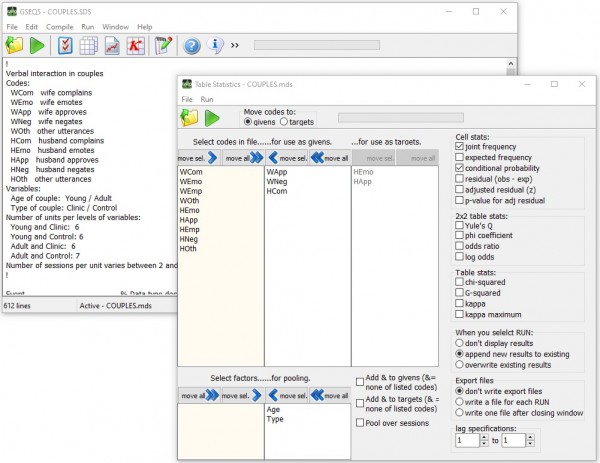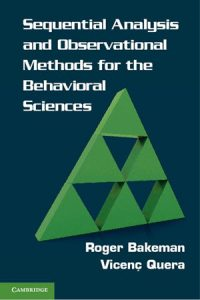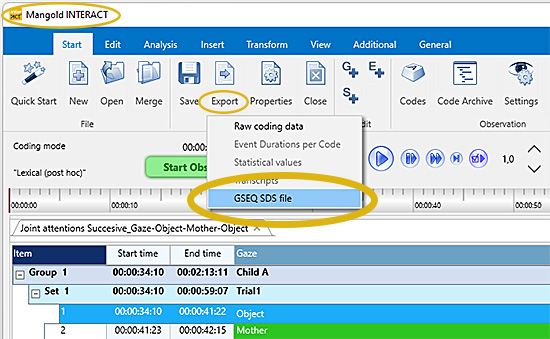GSEQ
Free Software for the Analysis of Interaction Sequences
GSEQ and SDIS Software

The Generalized Sequential Querier is a computer program for analyzing sequential observational data. It computes a variety of simple and contingency table statistics. Simple statistics include frequencies, rates, durations, and proportions (percentages).
Table statistics include joint frequencies, adjusted residuals, chi-squares and, for 2x2 tables, Yule's Q and odds ratios. Statistics can be computed for various lags, and separately for each session or pooled over sessions, levels of a factor, or both.
The Sequential Data Interchange Standard is a language for describing sequential data as obtained thru direct observation of individuals, interacting dyads, or groups. GSEQ includes a compiler for SDIS-formatted data files that converts them into MDS files (modified SDS files), which are then analyzed with the various analytic procedures included in GSEQ.
Data can be entered manually into SDIS files, or converted from other data formats such as those used in Mangold's INTERACT and Noldus' The Observer videoanalysis software using our standalone utilities ActSds, OdfSds (The Observer Version 5 and earlier), and ObsTxtSds (The Observer Version 6 and later).
Data modification: GSEQ's data modification capabilities expand analytic possibilities. New codes can be created form existing ones using standard logical operations (e.g., and, or, not) or by recoding, lumping, and chaining. The window command is especially useful. It lets you define new codes (windows) that are tied to onsets and/or offsets of existing codes and, in particular, perform time-window sequential analyses.
Exportation: A major use of GSEQ is to produce statistics for export that are then analyzed by standard statistical packages such as SPSS or SAS or by standard spreadsheet programs such as Excel. More generally, GSEQ's output consists of simple tab-delimited text files that can be read into and manipulated by any spreadsheet program.
Data plotting and interobserver agreement: GSEQ also includes helpful data plotting routines and procedures for assessing interobserver agreement with event-based and time-based kappas.
GSEQ Program and Book

The current version is GSEQ 5, a new and significantly improved version of GSEQ.
It runs under Windows and on other operating systems that run Windows simulation software. It is described in:
Bakeman, R., & Quera, V. (2011). Sequential Analysis and Observational Methods for the Behavioral Sciences. Cambridge, UK: Cambridge University Press. ISBN: 9781107001244 (hdcv), 9780521171816 (ppbk).
Link: Cambridge University Press Link: Amazon.com
The initial DOS versions of GSEQ were described in:
Bakeman, R., & Quera, V. (1995). Analyzing Interaction: Sequential Analysis with SDIS and GSEQ. Cambridge, UK: Cambridge University Press. ISBN: 0-521-44451-9 (hdcv), 0-521-44901-4 (ppbk) [out of print; may be hard to find]
SDIS was first defined in:
Bakeman, R., & Quera, V. (1992). SDIS: A sequential data interchange standard. Behavior Research Methods, Instruments, and Computers, 24, 554–559.
Downloads
GSEQ and the Mangold INTERACT Software
If you want to use GSEQ in combination with INTERACT, check-out the easy data export directly to a GSEQ SDS file from within INTERACT.
This is a full replacement of the previous ActSDS conversion tool.

GSEQ 5
GSEQ Version 5.1 includes new algorithms for computing interobserver agreement, both for event and timed-event sequential data, which are described in:
Bakeman, R., Quera, V., & Gnisci, A. (2009). Observer agreement for timed-event sequential data: A comparison of time-based and event-based algorithms. Behavior Research Methods, 41 (1), 137-147.
Quera, V., Bakeman, R., & Gnisci, A. (2007). Observer agreement for event sequences: Methods and software for sequence alignment and reliability estimates. Behavior Research Methods, 39 (1), 39-49.
Note: The MDS file format for GSEQ 5 differs from earlier versions. Earlier SDS files need to be recompiled for use with version 5.
Unzip and run the setup to install the program.
Thereafter, to run GSEQ, click Start > Programs > GSEQ5 > GSEQ 5.1, or click on the GSEQ desktop icon.

OdfSDS
ObsTxtSds (Noldus' The Observer to SDIS converter) converts Version 6 and later Noldus' The Observer data files into SDIS files that can be subsequently analyzed by GSEQ.
Described in: Bakeman, R., & Quera. V. (2008). ActSds and OdfSds: Programs for converting INTERACT and The Observer data files into SDIS timed-event sequential data files. Behavior Research Methods, 40 (3), 869-872.
Unzip and run the program directly without installation. See the included PDF file describing the program.

ELign
A standalone program for aligning event sequential data by means of dynamic programming algorithms, and computing an alignment kappa.
Note that the ELign algorithm is included in GSEQ 5 as well; using GSEQ 5 for aligning event sequences and computing Kappa is easier than using ELign.
Elign is described in:
Quera, V., Bakeman, R., & Gnisci, A. (2007). Observer agreement for event sequences: Methods and software for sequence alignment and reliability estimates. Behavior Research Methods, 39 (1), 39-49.The ZIP file contains the executable file, ELign.exe, plus several sample SDIS data files.
Unzip and run the program directly without installation. See the included PDF file describing the program.

ILOG
A standalone program for log-linear analysis. Log-linear analysis can be useful for analyzing event sequential data in particular, as described in Chapter 11 of Bakeman and Quera (2011). GSEQ's Export N-way table utility writes files than can be read directly by ILOG. ILOG uses an Iterative Proportional Fitting (IPF) algorithm to estimate expected frequencies.
The current version is ILOG 4; an earrlier DOS version was described in: Bakeman, R., & Robinson, B. F. (1994). Understanding log-linear analysis with ILOG: An interactive approach. Hillsdale, NJ: Erlbaum.The ZIP file contains the executable, ILOG4.EXE, and a PDF file that describes the program.
Unzip and run the program directly without installation. See the included PDF file describing the program.
History
SDIS 1.0 was defined in our 1992 article (Bakeman & Quera, 1992). The first version of GSEQ, incorporating the first SDIS compiler and developed for IBM-compatible computers running the Disk Operating System (DOS), was released in 1995 (Bakeman & Quera, 1995). Initial versions of GSEQ were called SDIS-GSEQ, and ran in DOS. In 1997, we released the first GSEQ for Windows (GSEQ 3.0), followed by an expanded version (GSEQ 4.0) in 2001.
The current version, GSEQ 5, is a new and significantly improved version of GSEQ. The Windows interface has been redesigned. It is now more intuitive and simpler to use than earlier versions. The menu structure in particular has been simplified. Fewer windows are open at a time, typically only one or two. GSEQ 5 has been totally reprogrammed. As a result, there are now no limits on the number of codes, the numbers of factors, the number of factor levels, the number of behavior streams, etc., that existed in earlier versions. It is also faster.
Analyses are indicated largely by point and click (using buttons, check boxes, and lists). This replaces the command language of the earliest DOS version of GSEQ and the command-line generator of later versions. As a result, it is no longer necessary to generate, or keep track of, GSEQ command files.
The format for MDS files produced by the GSEQ 5 compiler differs from the format used in earlier versions. As a result, any SDS files compiled earlier need to be recompiled for use with GSEQ 5.
Versions:
1995-1996: DOS versions 1.1 (English) and 1.2 (Spanish) were published.
1996: DOS version 1.4 (bilingual English/Spanish). It included several enhancements and bug fixes.
1997: DOS version 2.0 (bilingual English/Spanish). It included major changes such as a new data type in the SDIS language (multievent sequences), more features in the data language itself, a new and more efficient binary format for compiled files (MDS 2.0), full integration of program PLOT in the SDIS-GSEQ User Interface, enhanced exportation capabilities, and so on.
1997-2000: Prototype GSW (GSEQ for Windows) versions 3.x. Multilingual (English/Spanish/Italian). It ran in Windows 95 or later. The user interface was, of course, completely new, and included a command composer, MDS file displayer and plotter, and tools for computing observer agreement indexes. SDIS specifications were enhanced.
2001: GSW (GSEQ for Windows) version 4.0 is released. It includes several enhancements in analysis commands, and a new HTML help system.
2002: GSW (GSEQ for Windows) version 4.1 is released. Memory size is increased (bigger lag tables can be requested, more codes can be specified in data modification commands, codes and labels can contain more characters, and so on), and the HTML Help system is updated.
2006: Protection is removed from GSW 4.1.2, so that the Windows version no longer needs a key file from the original DOS program.
2007: New versions GSW 4.1.3, 4.1.4 and 4.2.0, with some bugs fixed.
2008: New version GSW 4.2.0, for Windows Vista and older Windows versions.
2008: Transitional version GSW 4.5.0 to 5.0.
2009: New version GSEQ 5.0, completely reprogrammed for current versions on Windows. It includes new algorithms for observer agreement, and a new Help system. GSEQ 5 uses point-and-click for data modification and analysis, not command files as in earlier versions. It also supports batch processing (command files) for data modification commands.
2011: New version GSEQ 5.1, with a streamlined interface and a new utility for exporting multidimensional lag tables.
2013: Version 5.1.15, with an updated look, minor bug fixes, and some enhancements (e.g., the kappa routine provides code-wise kappas, the window data modification command can accept two codes).
2016: Version 5.1.23, with a new logo and minor bug fixes.
2019: Transfer of maintenance and further development for all of the above programs to Pascal Mangold
Contact us / Feedback
Please send us your comments and suggestions.
We'd appreciate it if you would let us know:
Which version of GSEQ you are currently using.
When you started using GSEQ.
What your research topic is and what you are using GSEQ for.
Which observational data acquisition, or video analysis, software you use (INTERACT, The Observer, …).
What features of GSEQ you like, dislike, or would like to see in future versions.
Also, please report any malfunctions, errors, or bugs in GSEQ. We'll try to work on them as soon as we can.
Send us email (click on the link below our pictures).

Pascal Mangold



